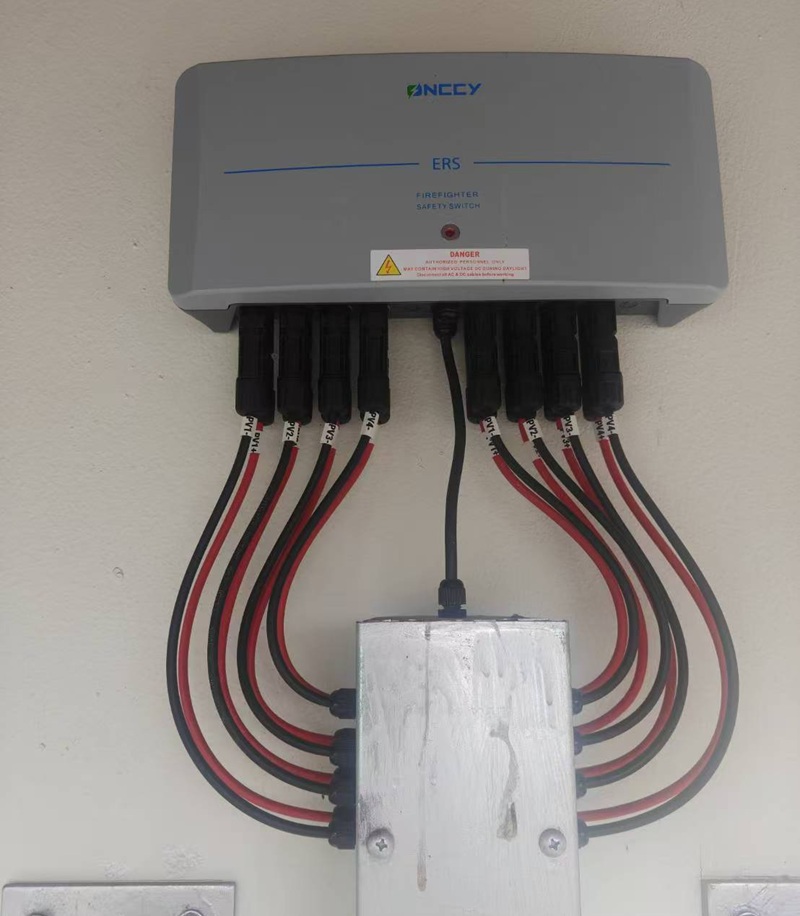Introduction
As the use of rooftop and commercial photovoltaic (PV) systems grows, ensuring system safety becomes more critical—especially when it comes to emergency scenarios like electrical arcing or fire. String-level rapid shutdown devices are key safety components designed to reduce DC voltage quickly, making solar systems safer for both maintenance personnel and emergency responders.
In this article, we will cover how to properly install string-level rapid shutdown devices and implement fire prevention measures to ensure PV system safety.
What is String-Level Rapid Shutdown?
String-level rapid shutdown is a protective mechanism integrated into PV systems that reduces string voltage to a safe level (typically below 30V) in emergency conditions such as fire, arc faults, or manual disconnection. This is particularly important in rooftop installations where high DC voltage poses significant risk.
How to Install String-Level Rapid Shutdown Devices
1. Installation Position and Mounting
Rapid shutdown devices should be installed close to the PV module—either on the module frame or near the junction box. The location must be protected from direct sunlight, rain, snow, or excessive dust. Ensure adequate airflow between the device and the module (e.g., a minimum 12.7mm clearance as required by SmartTrack04).
Use only manufacturer-recommended brackets or clips to mount the device securely while maintaining ease of maintenance.
2. Electrical Connections
Input Connection: Connect the input terminal of the shutdown device to the output terminal of the PV module’s junction box.
Output Connection: Connect the output terminal in series with the next string or to the inverter’s input.
Installation Tips:
Cable bending radius should exceed 50mm to prevent mechanical stress.
Never short-circuit the output terminals, as it may damage the device.
Use DC connectors that match the system specification. Mismatched connectors may cause failure and void the warranty.
3. Communication and Control Integration
Rapid shutdown units communicate with the PV monitoring and control systems using:
Wireless (RF)
Power line communication (PLC)
Wired communication (RS485 or Ethernet)
These units can be triggered through:
Manual shutdown buttons (e.g., Tigo’s PV-Safe Button)
Automatic shutdown via AC disconnection (e.g., in case of grid loss)
Ensure the system supports remote monitoring and fault alarms for timely detection and response.
4. System Testing and Commissioning
Once all strings are connected, test the entire system before connecting it to the inverter. Validate:
Response time of shutdown devices
Voltage drop performance in line with industry standards
Only proceed when the system meets all safety benchmarks.
Fire Prevention Measures for PV Systems
1. Role of Rapid Shutdown in Fire Safety
Rapid shutdown devices significantly reduce the risk of fire by lowering the DC voltage during emergency scenarios:
Within 30 seconds: string output voltage should drop below 30V
Within 305mm of module boundary: voltage should remain between 80–120V
This reduction minimizes the risk of electrical shock and arc-induced fires.
2. Advanced Arc Detection Technology
Modern shutdown devices feature:
High-frequency current transformer-based arc detection
Node-level DC arc sensing
Response time under 20 milliseconds
Voltage drop to 0V within 1 second
In addition, temperature sensors built into the device can cut power if the internal temperature exceeds 85°C, preventing heat-related fire hazards.
3. Emergency Operation and Firefighting Protocol
In case of fire, immediately shut off the AC main switch to trigger automatic shutdown.
Firefighters should receive training on solar system hazards and avoid direct contact with live components.
Use non-conductive extinguishers, such as dry chemical agents.
Ensure your system design complies with regional and international safety codes like NEC 2017 690.12 and local fire department requirements.
4. Use High-Quality Materials and Certified Devices
Select shutdown devices made from fire-resistant and flame-retardant materials.
Use certified products that meet IEC, UL, or national safety standards.
High-quality components enhance the system’s resilience under extreme conditions.
Conclusion
Proper installation and safety measures for string-level rapid shutdown systems are crucial to ensuring the safe operation of solar PV installations. From selecting the correct mounting location and cabling methods to integrating smart communication and fire-prevention features, every step must be handled with care and professionalism.
By using certified equipment, following relevant standards, and training personnel in emergency procedures, system operators can minimize the risk of fire and ensure long-term safety and reliability of the solar power system.

